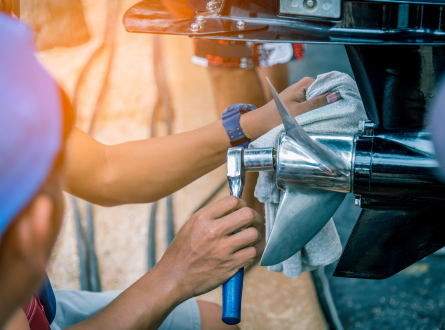Cavitation: A Silent Menace to Your Boat Propeller and How to Combat It
In the vast world of boating, one silent destroyer lurks beneath the surface, eating away at the integrity and performance of your boat’s propeller. It's known as cavitation. This not-so-visible enemy, however, can be tamed and controlled if you understand its intricacies. In this post, we will delve into the details of cavitation, its negative effects on your propeller, signs to look out for, and how to mitigate its impact.
#WhatIsCavitation #BoatPropeller #BoatMaintenance
Understanding Cavitation
Cavitation is a phenomenon that occurs when the pressure on a liquid (in this case, water around your propeller) decreases, creating vapor-filled cavities in areas of low pressure. When these vapor bubbles collapse, they generate shock waves that can damage the propeller's material over time, leading to performance issues and eventual failure.
Cavitation is often caused by the rapid change in pressure exerted by a propeller’s movement, exacerbated by high rotational speeds, excessive propeller loading, or even an incorrectly designed or damaged propeller.
#UnderstandingCavitation #BoatScience
The Negative Effects of Cavitation on a Propeller
The tiny vapor bubbles generated during cavitation might seem harmless at first, but they can pack quite a punch. The collapse of these bubbles produces strong shock waves that pummel the propeller's surface, leading to material degradation known as cavitation erosion. This degradation can lead to the following consequences:
Propeller Erosion: The constant impact of cavitation can erode the propeller blades, leading to decreased efficiency, vibrations, and possible propeller failure.
Reduced Efficiency: Cavitation causes a drop in the propeller's performance, reducing your boat's speed and increasing fuel consumption.
Noise and Vibration: Cavitation generates noise and excessive vibrations, which can lead to a less comfortable ride and cause damage to other boat components over time.
#PropellerErosion #ReducedEfficiency
Recognizing the Signs of Cavitation
Boat owners should remain vigilant for the signs of cavitation, which often include:
- Unusual noises: If you hear a high-pitched whining or a sound similar to gravel striking the hull, cavitation might be the culprit.
- Vibrations: Excessive or abnormal vibrations can indicate the presence of cavitation.
- Propeller damage: Visual inspection may reveal tiny pitted areas, or in severe cases, large chunks missing from the propeller blades.
#SignsOfCavitation
How to Minimize Cavitation
While cavitation cannot be entirely eliminated, it can be minimized by taking the following steps:
- Correct Propeller Selection: Ensure your propeller is correctly sized and designed for your boat. A propeller that is too large or too small can increase the risk of cavitation.
- Reducing Speed: Operating your boat at lower speeds can help reduce the possibility of cavitation.
- Regular Propeller Inspection and Maintenance: Regular inspections can help detect early signs of cavitation damage, enabling timely intervention.
#PreventingCavitation #BoatSafety
Propeller Maintenance: A Key to Longevity
A well-maintained propeller not only helps minimise cavitation but also ensures your boat operates at peak performance. Here are some key maintenance tips:
- Regular Inspection: Examine your propeller for any signs of wear, nicks, or dents, especially before and after long trips.
- Prompt Repairs: If you notice any damage, no matter how small, get the propeller repaired promptly to prevent further deterioration.
- Periodic Replacement: Propellers don't last forever. If your propeller is old or has sustained significant damage, consider a replacement.
#PropellerMaintenance #BoatingTips
To conclude, understanding and combating cavitation can significantly improve your boat's performance and lifespan. By paying attention to the signs, selecting the right propeller, operating your boat judiciously, and adhering to a strict maintenance schedule, you can keep cavitation at bay and sail smoothly for years to come.
#BoatingLife #SmoothSailing


Comments